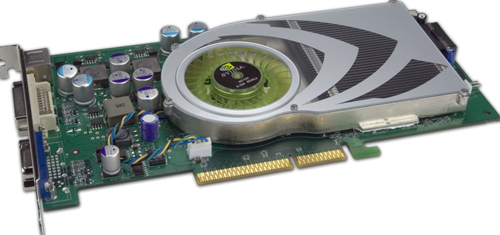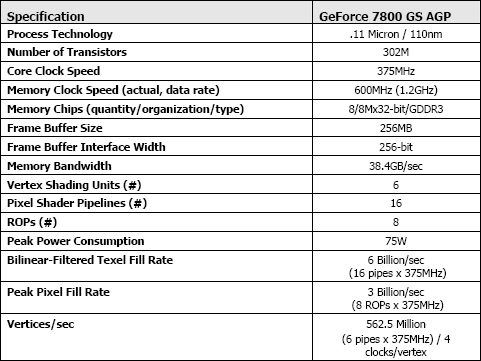The Card and The Test
As mentioned, we currently have both a 7800 GS from EVGA and the 7800 GS OC from BFG. Neither of these cards run at the default 375/1.2 clock speeds set forth by NVIDIA. For the purposes of these tests, we underclocked a card to the minimum speed that NVIDIA is endorsing. With the high clock speeds that we see from BFG and EVGA, we'd be willing to bet that even 7800 GS parts that don't come factory overclocked would have some head room. The EVGA card is clocked at core/mem clocks of 460/1.35, while the BFG part runs at 400/1.25. It is interesting to note that the BFG part makes a bigger deal out of being overclocked on the box than the EVGA card, but either way, the 7800 GS is no slouch.
Gigabyte K8U-939 ULi based motherboard
AMD Athlon 64 FX-57
2x 1GB OCZ PC4000 RAM @ 200MHz 2:3:3:8
160GB Seagate 7200.7 HD
OCZ 600W PowerStream PSU
For reference, we have included the 7800 GTX 512 and the X1900 XTX. This gives us a clear look at the highest end ATI and NVIDIA hardware available for both the AGP and PCIe platforms. The 7800 GT is also included in order to show us the performance of the next fastest NVIDIA part out there.
Here's a breakdown of the 7800 GS specifications as outlined by NVIDIA.
As mentioned, we currently have both a 7800 GS from EVGA and the 7800 GS OC from BFG. Neither of these cards run at the default 375/1.2 clock speeds set forth by NVIDIA. For the purposes of these tests, we underclocked a card to the minimum speed that NVIDIA is endorsing. With the high clock speeds that we see from BFG and EVGA, we'd be willing to bet that even 7800 GS parts that don't come factory overclocked would have some head room. The EVGA card is clocked at core/mem clocks of 460/1.35, while the BFG part runs at 400/1.25. It is interesting to note that the BFG part makes a bigger deal out of being overclocked on the box than the EVGA card, but either way, the 7800 GS is no slouch.


Gigabyte K8U-939 ULi based motherboard
AMD Athlon 64 FX-57
2x 1GB OCZ PC4000 RAM @ 200MHz 2:3:3:8
160GB Seagate 7200.7 HD
OCZ 600W PowerStream PSU
For reference, we have included the 7800 GTX 512 and the X1900 XTX. This gives us a clear look at the highest end ATI and NVIDIA hardware available for both the AGP and PCIe platforms. The 7800 GT is also included in order to show us the performance of the next fastest NVIDIA part out there.
Here's a breakdown of the 7800 GS specifications as outlined by NVIDIA.











93 Comments
View All Comments
mrkkbb007 - Thursday, February 2, 2006 - link
As I said in my earlier post. Head over to Tom's HW for comparison with a 6800 Ultra, the 7800 GS beats the 6800 Ultra AGP in almost all the latest games. The X850XT is still tops, but can't do the eye candy.ciparis - Thursday, February 2, 2006 - link
I'm a little shocked at the decision to ignore the actual speed these cards run at out of the box, and instead show an artificially limited card -- exclusively.
I wouldn't have minded seeing the "published spec" score, but not at the expense of knowing what you get if you walk into a store and walk out with one of these cards. Without that, this article is glaringly incomplete. I'm left little more informed about how an actual retail product performs than I was before I read it. That doesn't sound like AnandTech.
formulav8 - Thursday, February 2, 2006 - link
I agree that the reviews are subpar. I think anand should not be delegating as many reviews as he has been. You can ALWAYS tell which reviews he does from the moment you start reading it (a good thing). I guess he is just to busy these days to do more of them.Jeff7181 - Thursday, February 2, 2006 - link
Where is the 6800 Ulra or 6800GT in that review? How about a 6600GT? Come on guys... these are the cards that people who would consider buying a 7800GS own right now. Not including a 6800 or 6600 series in that review makes no sense at all.On a side note... AT has changed since I started visiting... I used to be able to get all the info I could ask for right here... now I have to visit 5 other forums to get the info I want, and that's not a good thing.
spinportal - Thursday, February 2, 2006 - link
here here.. this article is weak; run the cards at their OC speed, and then LABEL the REFERENCE Speed 7800 GS on the charts, since this is MISLEADING and *NOT* intuitive in comparisons when putting money down on the table.From a competition performance-cost standpoint, let's talk about bang for the buck here. This isn't a PREVIEW, this is about a card coming out in days.
How does the X1600XT 256MB, 6660GT 128MB, 6800 128MB rate in the $130 range.
Then its the sub 200$ range with the 6600GT or 6800 256MB versions.
We can all go thank Tom's HW site for the 2005 VGA charts to get a rough ball estimate due to the X850XT PE (which was not 210$ but rather in the $400+ range (from using pricegrabber). Not only that but they do compare the 7800GS against the 6800U and the BFG card is modestly beating the old tech. For the 300$ target price of the 7800GS AGP, there is a vast wasteland and no competition pricewise, but I feel its not justified to say it will drop 6800GT/U prices since it is no longer being manufactured (still going to be rare, and same performance, so why even bother getting an old large hot stinker of a card on E-bay-like services when you can get brand-spanking new tech?)
I'm still leering of why nVidia cannot see to get HDR and AA/AF to play nice, so I personally don't see much advantage in upgrading from a 6600GT / 6800 GT / U part just for SM 3.0. If the 7800GS is ~30% faster than a 6600GT, ~11% faster than a 6800 GT, and barely ekes out victory over a 6800 U, it doesn't do justice to upgrade unless you need to make the leap from TurboCache or integrated. I do hardware (& sys building) recommendations for many people and want to steer them in the right direction and make them feel they got the best value. Will this make people put off buying an M2 & PCI-e mobo for another year and stick with AGP? I'm not in the business of making predictions, but for me personally, I would rather get an X2 chip, mobo, and X1900 or 7800GTX (or maybe even the refresh to choose from), possibly an Creative X-Fi entry (but highly doubtful, shrug to the 5.1 audiophiles because there is a lack of a stand out digital spdif 5.1 headset - this boggles my mind and is another side topic) and 2GB of DDR2-667 RAM right about xmas 2006. I never find a truly good integrated PC builder that satisfied my DIY urges.
mrkkbb007 - Thursday, February 2, 2006 - link
The 6800 Ultra looses the lead in comparison to 7800 GS. Head over to toms hardware to see benchmark scores. I have an Opteron 146 w/ socket 940 and 2GB ECC-DDR400 that I received from work, but it has an ATI 9600SE. The 7800 GS is exactly what I have been waiting for since upgrading to a 939 with PCI-E is useless and will cost me more than a 7800 GS. The 7800 GS should give my system usefull life for a year at least, maybe more and it will be half the price of a 6800 Ultra.Cheers
phusg - Thursday, February 2, 2006 - link
I'd be interested in a comparison between the XT1600 and the 7800 GS AGP cards. They are my 2 candidates for a low power, high performance AGP card for my HTPC. I think many other HTPC owners would be interested in this as well, especially how the HDTV performance and quality compares on older CPUs.Mithan - Thursday, February 2, 2006 - link
Wish you guys had included a 6800GT or Ultra in here.puffpio - Thursday, February 2, 2006 - link
Could you add one more line showing how the card benches at the EVGA default overclock? Or maybe do your own overclock and test?Since this is the last bastion of AGP performance, I don't think any of us AGP users will want to stock clock this..
DrZoidberg - Thursday, February 2, 2006 - link
Yeah i cannot see why Anandtech decided not to show default factory o/c scores from evga. Sure if AT wanted benchmark with 7800gs underclocked but ALSO include 7800gs standard retail overclock benchmark.I mean the consumer who buys the evga 7800gs is not going to underclock the card by 20% from 460/1.35 to 375/1.2 and lose 20% performance.